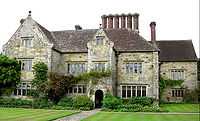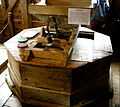Bateman's

Bateman's is a 17th-century house located in Burwash, East Sussex, England. Author Rudyard Kipling lived in Bateman's from 1902 to his death in 1936. His wife left the house to the National Trust on her death in 1939, and it has since been opened to the public.
House

Exterior
Bateman's is a modest Jacobean Wealden sandstone mansion built in 1634 for a local ironmaster, John Brittan. Six brick columns form a massive central chimneystack above the gabled facades.
Interior
Today the rooms are left as they were when the Kipling family lived there. Kipling and his wife created interiors that complemented the 17th-century house. The heart of the house is the book-lined study, at the top of the stairs, where Kipling worked. He sat at a 17th-century walnut refectory table under the window and his writing tools, paperweight, and pipe are still there.
Bateman's also reflects Kipling's strong links with the Indian subcontinent. There are oriental rugs in many rooms and the parlour displays Kipling's collection of Indian works of art and artefacts. His bookplate shows a small figure reading on top of an elephant. Exhibition rooms contain manuscripts, letters, and mementoes of Kipling's life and work.
History and setting for books

When Kipling first went to Bateman's on a house-hunting expedition in 1900 he fell in love with it at first sight. He purchased it in 1902, and made it his home, even paying for a new road to be built to the nearest main road. Kipling wrote some of his finest works here including: "If—", "The Glory of the Garden", and Puck of Pook's Hill, named after the hill visible from the house. The house's setting and the wider local area features in many of his stories in Puck of Pook's Hill (1906).
Kipling's poem The Land is inspired by the Bateman's estate.[1]
Bateman's was also used in the coloured 1966 edition of Tintin, 'The Black Island' as the basis for the residence of Müller, the ex-Nazi antagonist.[2] In the fictionalised adventure, the house is razed to the ground when a burning log from the hearth is used as a weapon during a scuffle.
Exterior scenes for the TV film My Boy Jack about the death of Kipling's young son Jack in the First World War and his family's grief were shot at Bateman's.[3][4]
Mill
There is a working watermill on the property using the waters of the River Dudwell, supported by volunteers.[5] The mill race drives the waterwheel outside, and this in turn drives the wooden cogwheels on the ground floor inside. These transfer power upstairs to the millstones. One pair of millstones is encased in wood and has a bell to warn the miller when the corn in the hopper runs out. In the grinding process the corn keeps the millstones apart, preventing sparks and a fire risk. The bell has a strap which is held down by a full hopper of corn. When the hopper is nearly empty, the strap is released, thus ringing the bell.[6]
-

Batemans mill
-

Wooden cogwheels on ground floor taking power from waterwheel
-

Cogwheels transferring power upstairs
-

Cogwheels turning grindstones above
-

Treen flour-mill tools
-

On first floor: millstones encased in wood
-

Alarm bell attached to millstones
References
- ↑ The Land: words and a sung version
- ↑ "History of The Black Island.". Archived from the original on 14 May 2011. Retrieved 2011-04-24.
- ↑ "Masterpiece: My Boy Jack". Cast, Production Credits, Web Credits. PBS. 2008. Retrieved April 14, 2013.
- ↑ "David Haig on My Boy Jack". Memorable TV. June 6, 2012. Retrieved April 14, 2013.
- ↑ "Sussex Mills Group". Volunteers are associated with this group as well as others. Retrieved 2009-08-03.
- ↑ Information from exhibit label
External links
| Wikimedia Commons has media related to Bateman's. |
Coordinates: 50°59′22″N 0°22′44.6″E / 50.98944°N 0.379056°E
